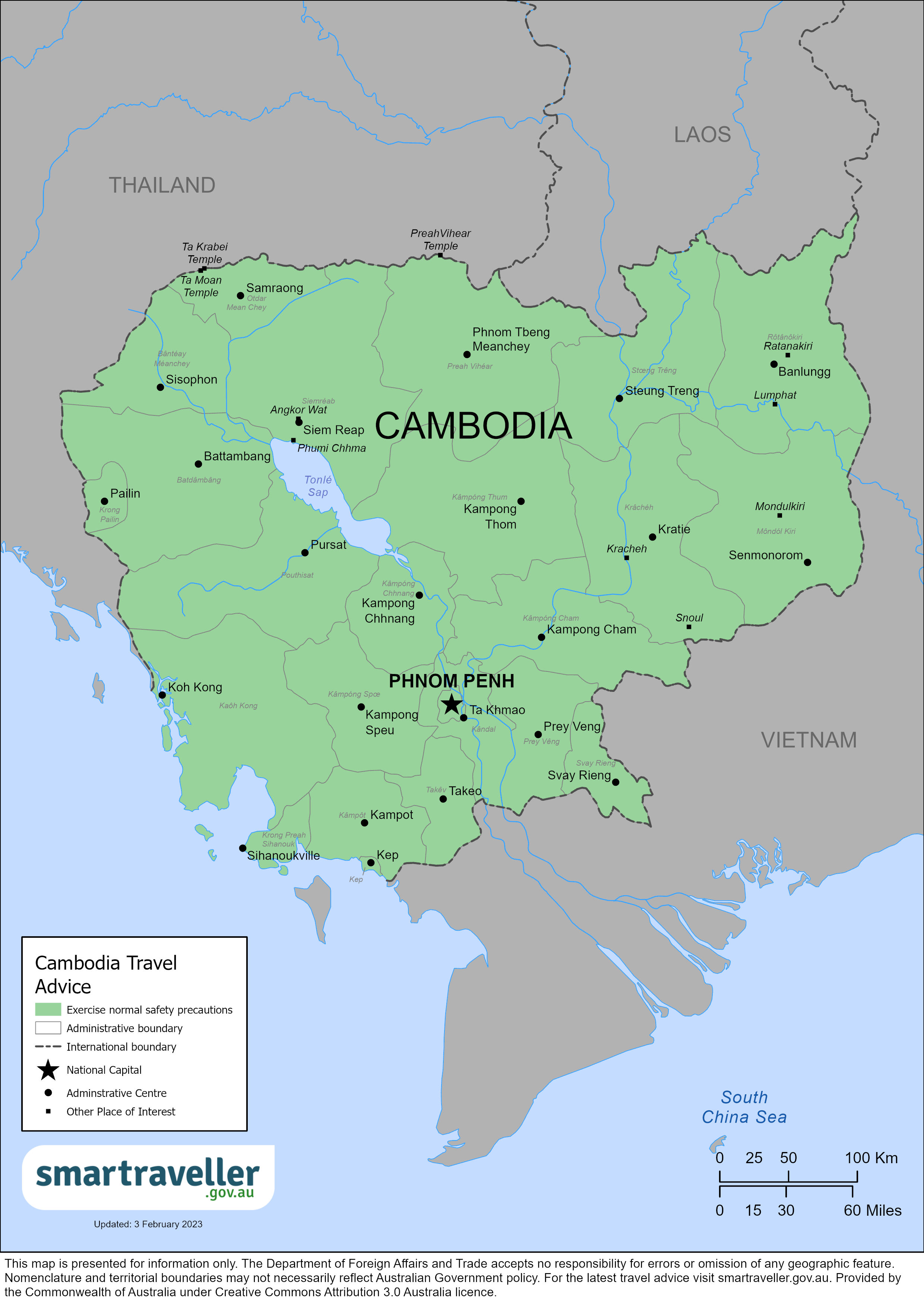Landmines
Landmines are a danger in many parts of Cambodia, especially along the border with Thailand.
Large areas of rural Cambodia still have live landmines.
If you visit the north and north-west of Cambodia, stay on marked pathways.
Take extra care if travelling away from the Angkor Wat temple complex to other temples in the Siem Reap area.
Driving permits
If you want to drive a car or ride a motorcycle larger than 125cc, you need a Cambodian driver’s (or motorcycle) licence, or your Australian licence and International Driving Permit.
You can apply for a Cambodian licence equivalent to your Australian licence in person at the Ministry of Public Works and Transport’s main Phnom Penh office or at their outlets located inside Aeon Mall 1 and Aeon Mall 2 in Phnom Penh and at the Heritage Walk mall in Siem Reap. If you do not have a valid foreign licence you will need to undergo testing at their main office to receive a Cambodian licence.
If using an Australian licence and International Driving Permit you can only operate the vehicles listed. You must carry both documents when operating a vehicle and comply with all Cambodian traffic law.
Under Cambodian law, you can ride a motorcycle with an engine capacity of up to 125cc without a licence. However, check with your insurer. Some travel insurers may not cover you for riding a motorcycle at all, even if you’re fully licensed. Others won’t cover riders unless they hold an Australian motorcycle licence, even if riding a motorcycle with capacity less than 125cc.
Road travel
Travel by road, especially at night outside major cities, is dangerous because of:
- poor road conditions
- drunk drivers
- wandering livestock
- the risk of crime
Be alert at all times on the roads and avoid travelling at night.
Driving standards are often poor. Vehicles and roads are often not well maintained.
Streets are crowded in major cities. Drivers often ignore road rules.
Serious injuries from road accidents happen every day in Cambodia. Motorcycles, buses and coaches have high accident rates.
Large crowds can form quickly after road accidents. If you’re in an accident, people might try to take advantage of you.
Speed limits for motorcycle drivers are:
- 30km per hour in towns
- 60km per hour on the outskirts
Other vehicle drivers can’t go over:
- 40km per hour in towns
- 80km per hour outside towns
You must wear a helmet when riding a motorcycle.
If you get a speeding ticket, you need to pay the fine at a payment centre within 30 days. Always ask for a receipt.
If you plan to drive:
- learn about local traffic laws
- avoid driving at night outside major cities
More information:
Motorcycles
Motorcycles are a common form of public transport in cities. Check your insurance policy covers you for motorcycles, either as a driver or passenger.
Always wear a helmet.
Most helmets in Cambodia don’t meet Australian standards. Bring a helmet and protective clothing with you if you’re:
- visiting Cambodia for a motorcycle tour
- expecting to travel a lot by motorcycle
Taxis and Tuk-tuks
Official, metered taxis are generally safe and convenient. However, be alert to possible scams and safety risks.
Registered drivers with ridesharing services are available in Phnom Penh, Siem Reap, and Sihanoukville. Limited services operate in Kampot and Battambang.
Flagged-down motorcycle taxis (moto), tuk-tuks and rickshaws are often used for short trips.
Many drivers do not use metered fares and may charge according to:
- distance travelled
- number of passengers
- time of day
Drivers sometimes take passengers without understanding their destination. Destinations are often identified by common landmarks, such as the nearest pagoda.
Before using a moto, tuk-tuk or rickshaw, you should agree on the fare with the driver, have some idea of the best route to take, or use ride-hailing apps such as Grab and Passapp.
Rail travel
Rail services are unreliable and limited. Expect frequent changes and interruptions to schedules with little notice.
More information:
Sea/River travel
Travel by boat can be dangerous.
Boats taking passengers to islands off the coast of Sihanoukville have sunk.
Even modern boats may be overcrowded and lack basic safety gear.
To help keep yourself safe on the water:
- ensure any boat you plan to board has suitable safety gear, including life jackets for all passengers
- always wear your life jacket, even if others don’t
- check with your tour operator or boat manager that safety standards are in place, including passenger and weight limits
If safety standards are not in place, find another boat.
More information:
Air travel
The safety and upkeep standards of local aircraft may be low.
Local airlines often cancel or reschedule flights at short notice.
DFAT doesn’t provide information on the safety of individual commercial airlines or flight paths.
Check Cambodia’s air safety profile with the Aviation Safety Network.
More information:
link

